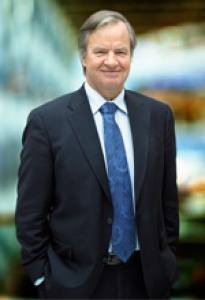Norwegian: Survival of the fittest in European aviation
 Bjørn Kjos is the chief executive and largest shareholder of Norwegian
Bjørn Kjos is the chief executive and largest shareholder of Norwegian He may not look much like it, but Norwegian chief executive Bjørn Kjos is like a child on his birthday.
He has a new plane to play with, the Boeing Dreamliner, but there is a small problem. It has no batteries.
The hitch means Norwegian will not be able to launch its much vaunted long-haul Boeing 787 flights to New York in April as planned (with Norwegian instead wet leasing two Airbus A340s to fly the route in the interim).
As Kjos explains: “We have taken a decision to take these wet lease planes for two and three months respectively; we are expecting delays of weeks, rather than months, in the delivery of the Dreamliner.
“Boeing is working incredibly hard to get the battery issues with that plane corrected. We have faith in them and will order more Dreamliners in the future.”
Sky-high
Outside of this small blip, things are taking off for Norwegian, which has grown over the past decade to become the tenth largest carrier in Europe.
In two weeks, on April 1st, the Scandinavian airline will open its first base in the UK, at Gatwick Airport, offering 145 non-stop flights a week to 21 destinations.
The four aircraft based there will principally cater to the leisure market, ferrying cost-conscience passengers to sunny climbs in Spain, Italy and Croatia among others.
The move is part of a wider strategy from Norwegian to cut costs ever further.
Basing planes across Europe – with the carrier also opening operations in Malaga, Las Palmas and Alicante in Spain – allow for savings which can be passed on to passengers in the form of cheaper tickets.
As Kjos continues: “There are going to be a lot fewer airlines in the next decade and, as in every industry, it will be survival of the fittest.
“Our emerging competitors are the Asian low-cost carriers – Scoot, JetStar and AirAsia; it will be these carriers that fly passengers to the emerging economic destinations.
“Their costs are incredibly low – something we must match.”
New Aircraft
Another component of this cost cutting ambition, alongside geographical diversification, is a zeal for new aircraft, with Norwegian operating one of the most modern fleets in Europe.
It currently consists of 74 aircraft, including some 64 Boeing 737-800s and ten Boeing 737-300s.
Vitally, the average fleet age is just 4.6 years, with 65 Boeing 737-800, 100 Boeing 737 Max-8 and 100 Airbus A320neos also on order to replace aging planes.
“Fuel efficiency is key; the older the plane, the more they cost to run,” continued Kjos.
“We operate our aircraft, ideally, for seven years, keeping our fleet new and costs down.”
Norwegian estimates a new Dreamliner – of which it has eight scheduled for delivery over the next three years – costs £5.7 million less annually to run than the ‘next best’ Airbus A330-200 due to fuel efficiencies alone.
Asian Markets
But it is economic shifts which most interest Norwegian.
Having just opened a base in Bangkok, the carrier is betting big it will be the economic development of China and its rival Asian destinations which will dominate the aviation sector over the coming years.
“We will be carrying more Asian passengers out of Asian in the coming years,” explains Kjos.
“Today 90 per cent of the people on our planes are Scandinavian, but this will decline sharply as the Asian economies develop and people there start travelling more.
“These are the people we will be carrying, into Europe, from Asia, where presently the opposite is true.”
But, while the future looks bright for the carrier, many of its competitors may be facing a bleaker future.
Kjos adds: “The critical mass to ensure survival for an airline is growing all the time.
“Only a few years ago you could survive with five planes. Now it is perhaps 40. In five years 50, and then within a decade it is likely to be 100.
“I see a lot of the smaller carriers disappearing, and not just at the low-cost end of the market. It is vital we grow all the time, with new planes, to stay ahead of the curve.”
Kjos had better start drawing up a list of presents he wants for next year.

